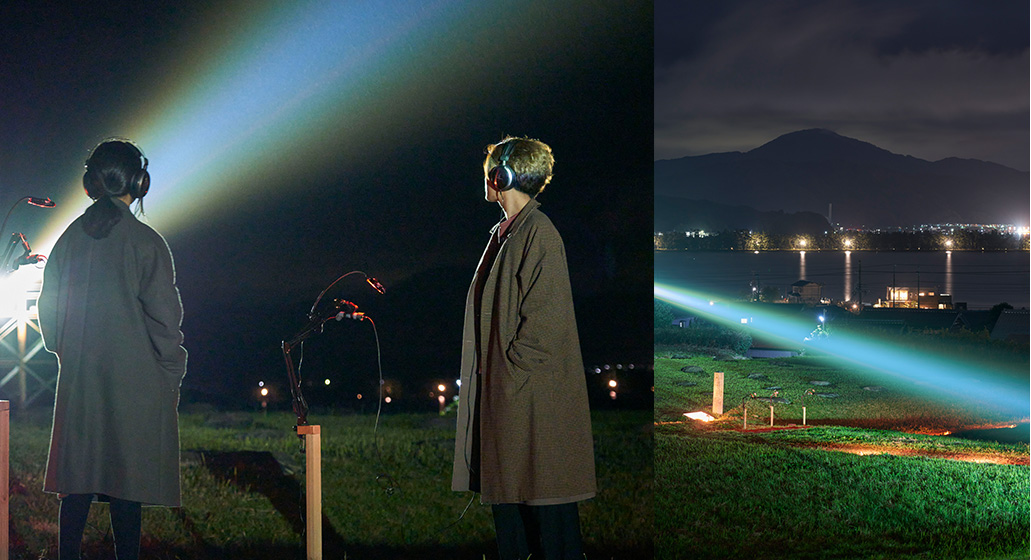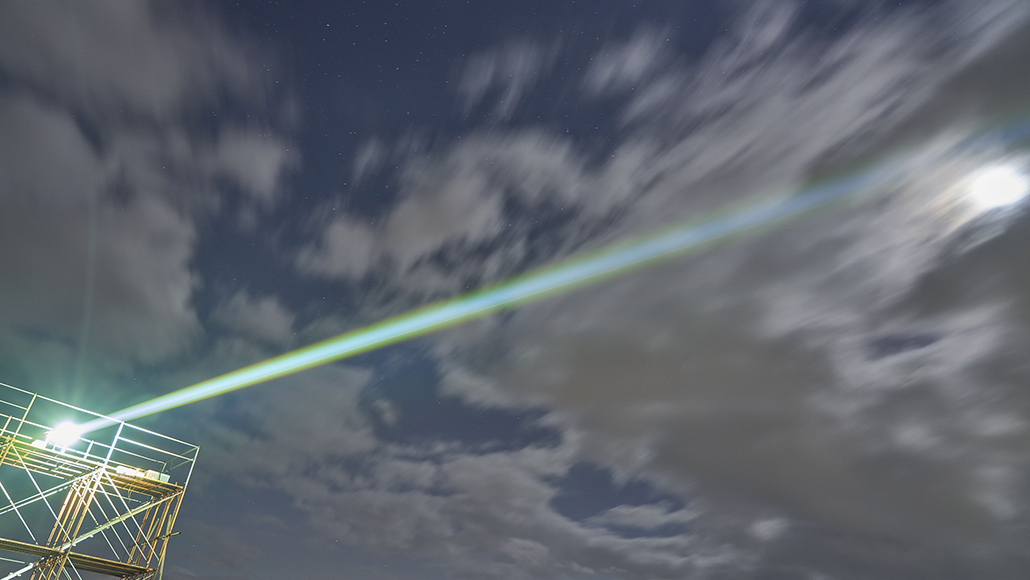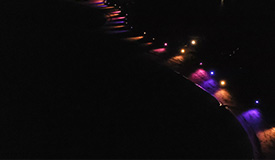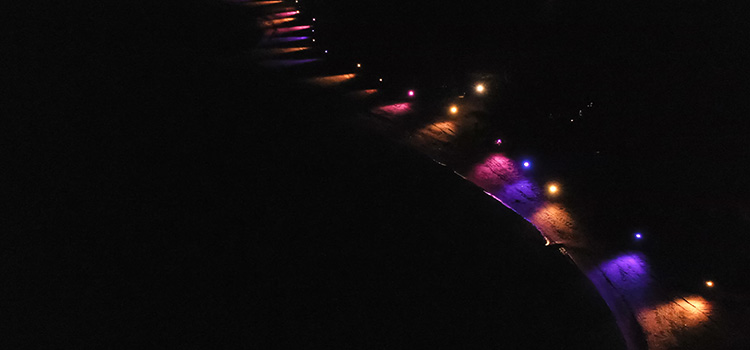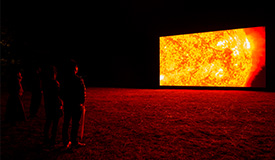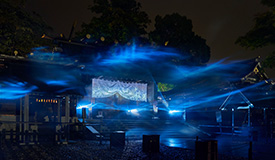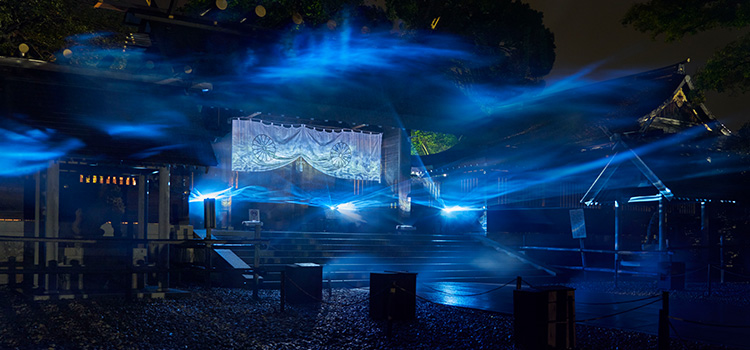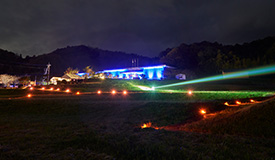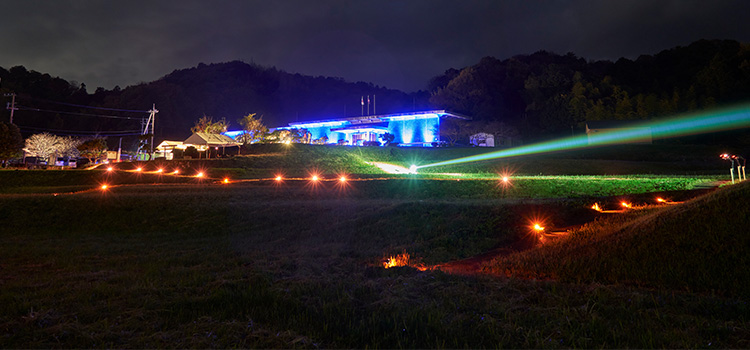2020 . 07. 11 sat ー 2020 .11 . 23 mon
Kyoto Prefecture creates new opportunities for visitors to explore local culture, by promoting multiple projects that increase tourism and stimulate the local economy. One such project, the digital art project, “Artspace of the Light.” Combining high-technology and local culture, this project is a digital art space woven into some of the country’s most famous cultural heritage locations, themselves set among wondrous natural landscapes. In 2020, Amanohashidate, one of Japan’s “three most scenic spots,” featured such a project called “Between Reality and Fantasy,” which used light, moving image, and sound to create a fantastical experience.
Light and Sound
07.11.Sat – 09.30 Wed, 19:00 – 22:30
For centuries, Amanohashidate has been known as one of the “Three Most Scenic Views of Japan.” The uniqueness of the sand spit has inspired human beings since ancient times, and is the subject of many mythical stories.
On this special occasion, sound artist Marihiko Hara who works on the texture / the silence of the soundscape, and lighting designer Shiho Nagamachi who created the lights arrangement in the environments, turned the Amanohashidate beach into a dream-like atmosphere of sound and light.
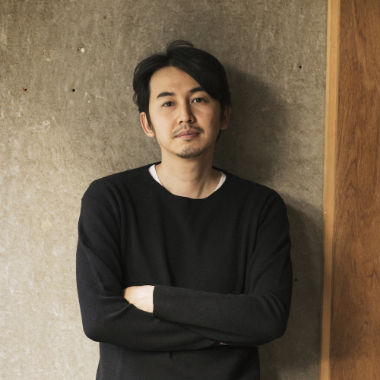
Musician Marihiko Hara
Graduated from the Department of Education, Kyoto University. His main interest is to compose serene silence in music and to pursue his own texture of sounds, through electric/acoustic sounds and field recordings. He released the album “Landscape in Portrait” in 2017, mixing melodic piano and electric abstract sounds. He produces music for theatre performances and collaborates with people involved in many fields, such as Ryuichi Sakamoto, “Vessel” by Damien Jalet and Kohei Nawa, Hideki Noda’s plays, Paris Fashion Week and Kabuki Theatre.

Lighting Designer Shiho Nagamachi
Graduated from Kyoto Institute of Technology, visiting professor at Kyoto University of Art and Design, part-time lecturer at Osaka University. She practices a variety of projects such as urban planning night scene design in public space, lighting plan for architecture and landscape, tourism town development with light at the core, public light art, and production of lighting brand. Recent works “Kobe City Meriken Park” “Mizuki Shigeru Road” “Kusatsugawa Park” “Dojima Bridge Light Up” “Nusamaibashi Light Up” “Nagato Town Development” “INAKA Illumi Ohnan” Other
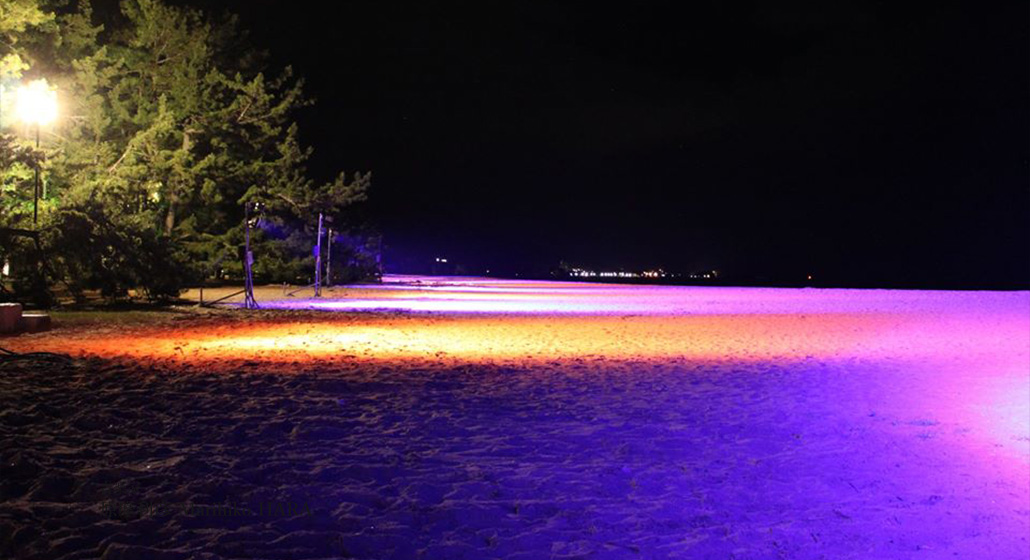

Light and Sound
07.11.Sat – 09.30 Wed, 19:00 – 22:30
For centuries, Amanohashidate has been known as one of the “Three Most Scenic Views of Japan.” The uniqueness of the sand spit has inspired human beings since ancient times, and is the subject of many mythical stories.
On this special occasion, sound artist Marihiko Hara who works on the texture / the silence of the soundscape, and lighting designer Shiho Nagamachi who created the lights arrangement in the environments, turned the Amanohashidate beach into a dream-like atmosphere of sound and light.

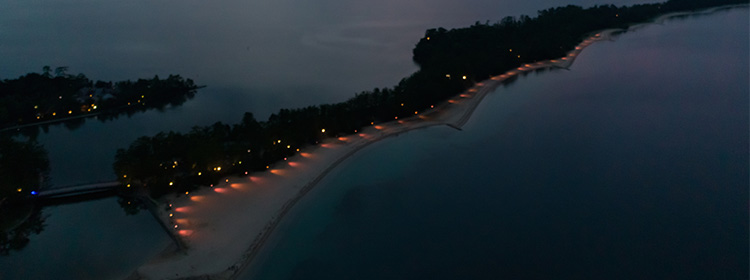

Musician Marihiko Hara
Graduated from the Department of Education, Kyoto University. His main interest is to compose serene silence in music and to pursue his own texture of sounds, through electric/acoustic sounds and field recordings. He released the album “Landscape in Portrait” in 2017, mixing melodic piano and electric abstract sounds. He produces music for theatre performances and collaborates with people involved in many fields, such as Ryuichi Sakamoto, “Vessel” by Damien Jalet and Kohei Nawa, Hideki Noda’s plays, Paris Fashion Week and Kabuki Theatre.

Lighting Designer Shiho Nagamachi
Graduated from Kyoto Institute of Technology, visiting professor at Kyoto University of Art and Design, part-time lecturer at Osaka University. She practices a variety of projects such as urban planning night scene design in public space, lighting plan for architecture and landscape, tourism town development with light at the core, public light art, and production of lighting brand. Recent works “Kobe City Meriken Park” “Mizuki Shigeru Road” “Kusatsugawa Park” “Dojima Bridge Light Up” “Nusamaibashi Light Up” “Nagato Town Development” “INAKA Illumi Ohnan” Other
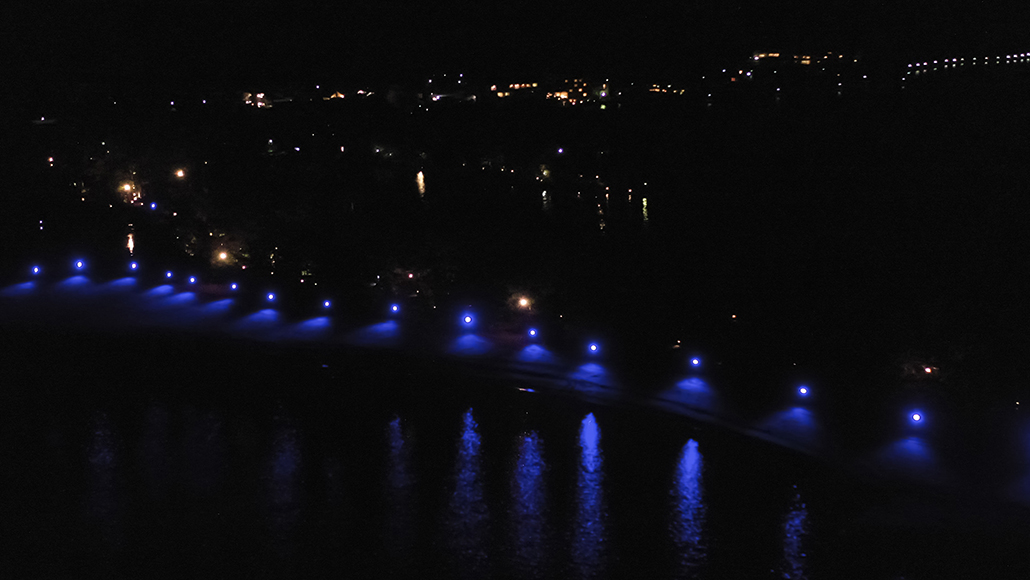
data-verse 1
10.16 . Fri – 11.3.Tues, 18:30~22:00
There was exhibited data-verse 1 by Ryoji Ikeda, one of Japan’s leading electronic music composers and visual artists.
The audio-visual work data-verse 1 that draws viewers into the vast world of data expresses the process of moving from the micro level to the human level to the macro level in three ways. Viewers, both visual and auditory, are drawn into the vast world of data, into the stream of data that overflows our everyday lives. By combining various elements such as acoustics, vision, materials, physical phenomena, and mathematical concepts in an integrated manner, Ikeda, which transcends existing concepts, explores the limits of human senses and digital technology while exploring “extreme”, and the “infinite” world. Experienced his work, which is open to the imagination of the viewer, without being restricted by his own words.

Artist Ryoji Ikeda
born in 1966 in Gifu, Japan. lives and works in Paris, France and Kyoto, Japan.
Japan’s leading electronic composer and visual artist Ryoji Ikeda focuses on the essential characteristics of sound itself and that of visuals as light by means of both mathematical precision and mathematical aesthetics. Ikeda has gained a reputation as one of the few international artists working convincingly across both visual and sonic media.Alongside of pure musical activity, Ikeda has been working on long-term projects through live performances, installations, books and CDs. Ryoji Ikeda is represented by Almine Rech Gallery (Bruxelles, Paris, London , New York), and Taro Nasu Gallery (Tokyo)
concept, composition: Ryoji Ikeda
computer graphics, programming: Norimichi Hirakawa, Tomonaga Tokuyama, Satoshi Hama, Ryo Shiraki
commissioned by Audemars Piguet Contemporary
with special thanks to The Vinyl Factory
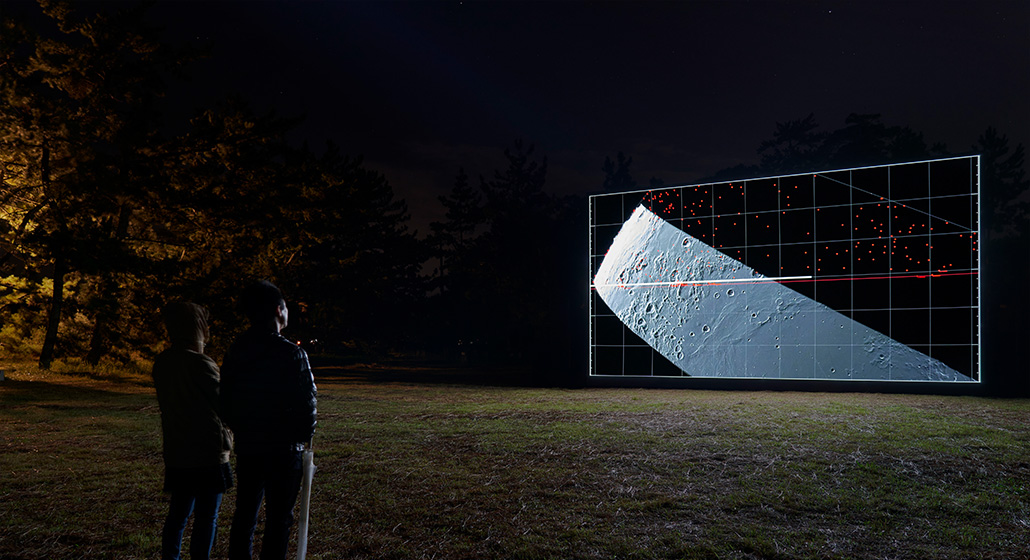

data-verse 1
10.16 . Fri – 11.3.Tues, 18:30~22:00
There was exhibited data-verse 1 by Ryoji Ikeda, one of Japan’s leading electronic music composers and visual artists.
The audio-visual work data-verse 1 that draws viewers into the vast world of data expresses the process of moving from the micro level to the human level to the macro level in three ways. Viewers, both visual and auditory, are drawn into the vast world of data, into the stream of data that overflows our everyday lives. By combining various elements such as acoustics, vision, materials, physical phenomena, and mathematical concepts in an integrated manner, Ikeda, which transcends existing concepts, explores the limits of human senses and digital technology while exploring “extreme”, and the “infinite” world. Experienced his work, which is open to the imagination of the viewer, without being restricted by his own words.

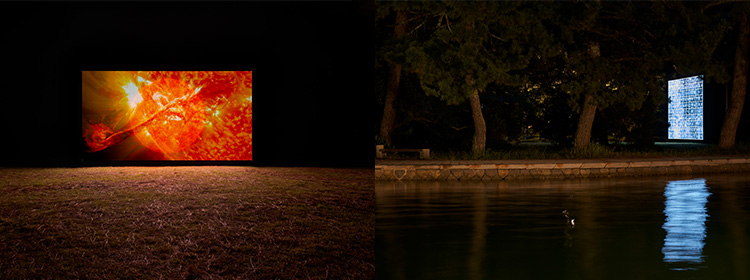

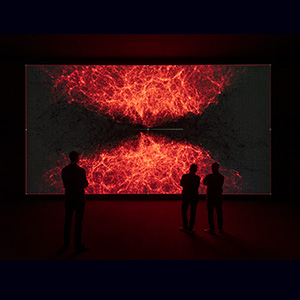
Artist Ryoji Ikeda
born in 1966 in Gifu, Japan. lives and works in Paris, France and Kyoto, Japan.
Japan’s leading electronic composer and visual artist Ryoji Ikeda focuses on the essential characteristics of sound itself and that of visuals as light by means of both mathematical precision and mathematical aesthetics. Ikeda has gained a reputation as one of the few international artists working convincingly across both visual and sonic media.Alongside of pure musical activity, Ikeda has been working on long-term projects through live performances, installations, books and CDs. Ryoji Ikeda is represented by Almine Rech Gallery (Bruxelles, Paris, London , New York), and Taro Nasu Gallery (Tokyo)
concept, composition: Ryoji Ikeda
computer graphics, programming: Norimichi Hirakawa, Tomonaga Tokuyama, Satoshi Hama, Ryo Shiraki
commissioned by Audemars Piguet Contemporary
with special thanks to The Vinyl Factory
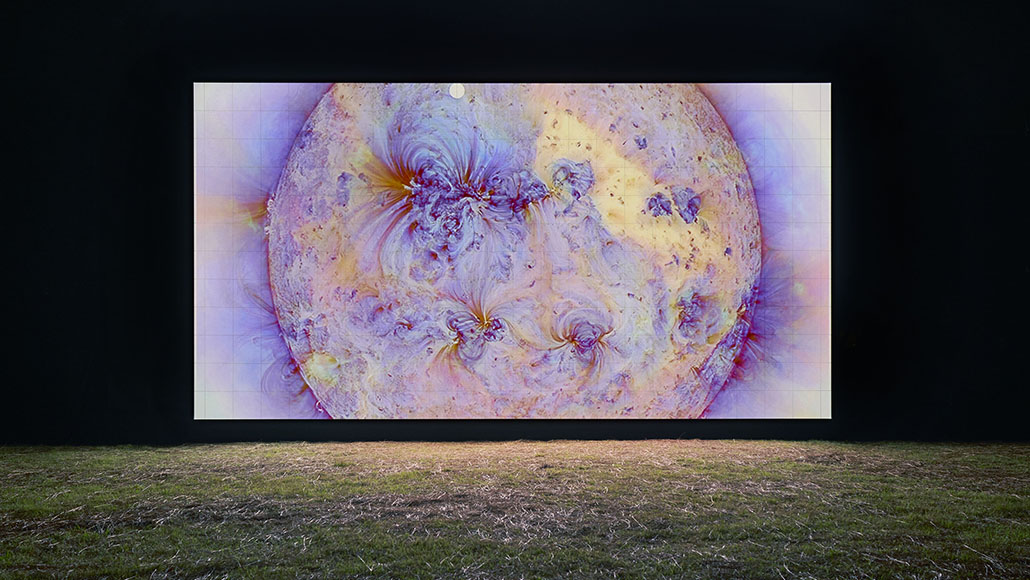
Double Horizon
10.16.Fri – 11. 23.Tues, 18:00~21:00
The interactive art director and media artist, Tatsuya Saito presents artwork Double Horizon which intends to describe the original meaning of Amanohashidate. In Japanese language, both the sea and the sky are called “Ama.” Why are these two different elements expressed with the same sound? Saito’s installation work suggests a space that —derived from the origin of Amanohashidate—looks beyond the horizon. The work was exhibited at the approach to Motoise Kono Shrine, a sacred place that inherently occupies a liminal margin between two worlds. Saito made use of looming fog and projections to give us the illusion of a three-dimensional sea surface, or flowing clouds.

Interactive Art Director, Media Artist Tatsuya Saito
After graduating from UCLA Department of Arts and receiving his Master’s degree from Tokyo University of the Arts, Tatsuya established his design studio Abacus. Based on his observations about the human senses & cognitive functions and media technology, he has been active in various fields such as advertising, production, television, literature and show. He has been awarded an award at the Japan Media Arts Festival, NY ADC Award, D&AD, Good Design Award, one show Gold Award, AD STARS Gold Award, ADFEST Gold Award, L’Oreal Art and Science of Color Prize Bronze Award, and Grand Prix and Award for Scientific Technology at Laval Virtual in France. Tatsuya’s works have been exhibited internationally at locations such as the ARS ELECTRONICA CENTER (Australia), 21_21 DESIGN SIGHT, NTT InterCommunication Center, and Ginza Graphic Gallery (ggg).
Engineering : Yuki Anezaki, Kye Shimizu (N sketch)
Motion Graphic : Marie Nagasue

Double Horizon
10.16.Fri – 11. 23.Tues, 18:00~21:00
The interactive art director and media artist, Tatsuya Saito presents artwork Double Horizon which intends to describe the original meaning of Amanohashidate. In Japanese language, both the sea and the sky are called “Ama.” Why are these two different elements expressed with the same sound? Saito’s installation work suggests a space that —derived from the origin of Amanohashidate—looks beyond the horizon. The work was exhibited at the approach to Motoise Kono Shrine, a sacred place that inherently occupies a liminal margin between two worlds. Saito made use of looming fog and projections to give us the illusion of a three-dimensional sea surface, or flowing clouds.
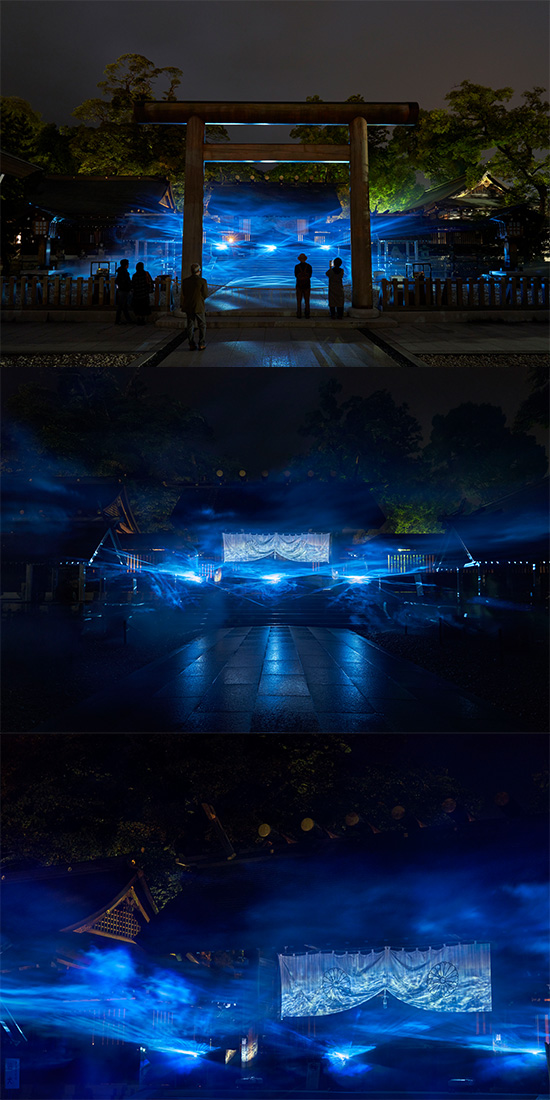
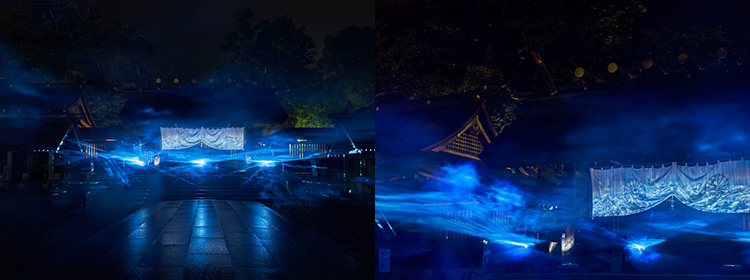

Interactive Art Director, Media Artist Tatsuya Saito
After graduating from UCLA Department of Arts and receiving his Master’s degree from Tokyo University of the Arts, Tatsuya established his design studio Abacus. Based on his observations about the human senses & cognitive functions and media technology, he has been active in various fields such as advertising, production, television, literature and show. He has been awarded an award at the Japan Media Arts Festival, NY ADC Award, D&AD, Good Design Award, one show Gold Award, AD STARS Gold Award, ADFEST Gold Award, L’Oreal Art and Science of Color Prize Bronze Award, and Grand Prix and Award for Scientific Technology at Laval Virtual in France. Tatsuya’s works have been exhibited internationally at locations such as the ARS ELECTRONICA CENTER (Australia), 21_21 DESIGN SIGHT, NTT InterCommunication Center, and Ginza Graphic Gallery (ggg).
Engineering : Yuki Anezaki, Kye Shimizu (N sketch)
Motion Graphic : Marie Nagasue
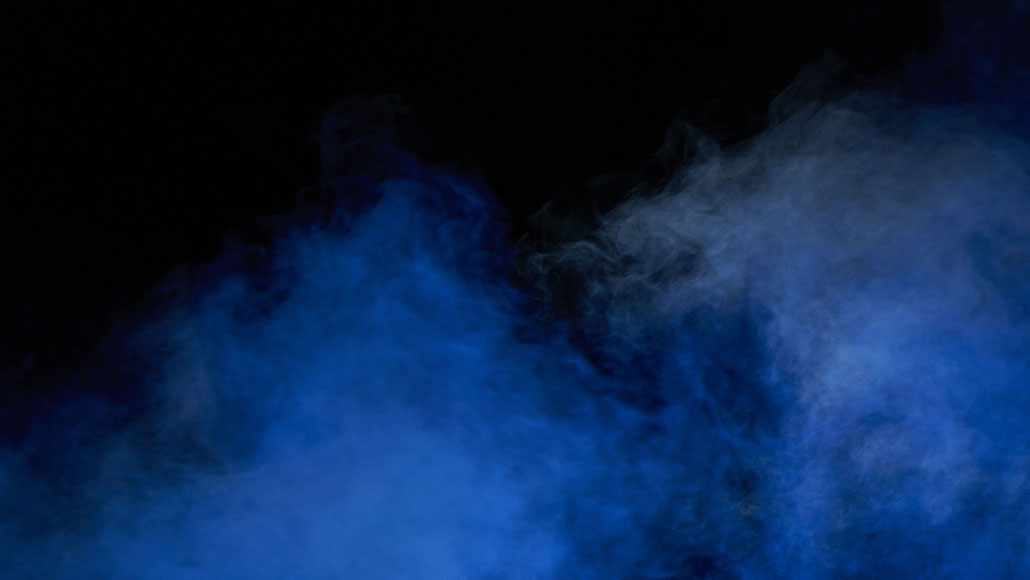
JIKU #009 TANGO_KOKUBUNJI
11.20.Fri – 11.23. Mon, Sunset - 21:00
Seiichi SAITO (creative director of Rhizomatiks Architecture) unveiled his latest artwork in the JIKU series. A site-specific artwork series, JIKU explores the hidden axis within this place, using light and sound to illuminate the invisible. Work #009 in the series took place in Tango Kokubunji Temple. The work finds its primary inspiration in the eye and mind of famed painter Sesshū Tōyō—uncovering this axis through Sesshū’s masterpiece “View of Ama-no-hashidate.”
The national treasure,Sesshū’s painting “View of Ama-no-hasidate”
For the first time in 40 years, it will come home to the Kyoto Prefectural Tango Regional Museum, located in the front of Tango Kokubunji Temple ruins. Since there is no actual place from which one can see the entire Amanohashidate area as it is painted in Sesshū’s work, it is presumed that he had visited multiple vantage points, and then connected what was in his mind to produce a single work. SAITO used light and sound in the “JIKU” series, tried and expressed the viewpoints that were in Sesshū’s mind.

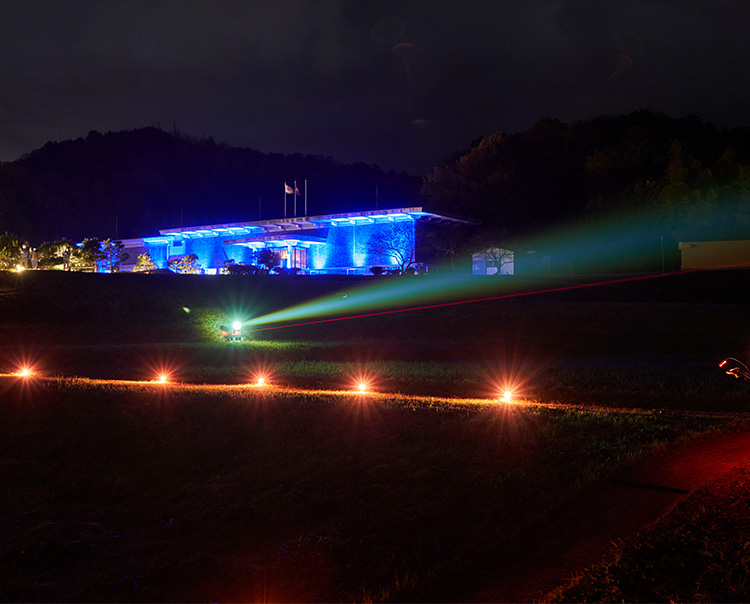
JIKU #009 TANGO_KOKUBUNJI
11.20.Fri – 11.23. Mon, Sunset - 21:00
Seiichi SAITO (creative director of Rhizomatiks Architecture) unveiled his latest artwork in the JIKU series. A site-specific artwork series, JIKU explores the hidden axis within this place, using light and sound to illuminate the invisible. Work #009 in the series took place in Tango Kokubunji Temple. The work finds its primary inspiration in the eye and mind of famed painter Sesshū Tōyō—uncovering this axis through Sesshū’s masterpiece “View of Ama-no-hashidate.”
The national treasure,Sesshū’s painting “View of Ama-no-hasidate”
For the first time in 40 years, it will come home to the Kyoto Prefectural Tango Regional Museum, located in the front of Tango Kokubunji Temple ruins. Since there is no actual place from which one can see the entire Amanohashidate area as it is painted in Sesshū’s work, it is presumed that he had visited multiple vantage points, and then connected what was in his mind to produce a single work. SAITO used light and sound in the “JIKU” series, tried and expressed the viewpoints that were in Sesshū’s mind.


Creative Director / Technical Director Seiichi Saito Rhizomatiks Architecture
Born in Kanagawa in 1975, Mr. Saito began his career in New York in 2000 after graduating from Columbia University with a Master of Science degree in Advanced Architectural Design (MSAAD). He produces works in the commercial art field which are three-dimensional and interactive while also being based on the firm grounding in logical thought that he cultivated through architecture. He currently serves as Director of Rhizomatiks Co., Ltd., while alsoGood Design Award 2015-2017 Jury. Vice Chairman of Good Design Award 2018. Creative Adviser of 2020 Dubai Expo Japan pavilion.
Creative Director : Seiichi Saito
Project Manager : Nozomi Yamaguchi
Lighting Programmer : Tatsuya Motoki
Space Design : Takahito Hosono
Music:Tetsushi Fujita
Music Producer:Motohiro Fujii(Backslash)
Assistant Music Producer:Setsu Tanaka(Backslash)
Equipment Cooperation : Audio-Technica Corporation
